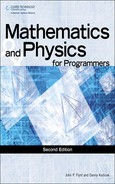Book Description
The casual game market continues to expand, and with the use of Flash growing and the increased popularity of the iPhone and other mobile gaming devices, developers have an exciting new route to market. But many of these budding game programmers find that they're missing the core math and physics skills they need to develop even simple games. MATHEMATICS AND PHYSICS FOR PROGRAMMERS, SECOND EDITION teaches beginning game programmers they skills they need to develop causal games. Beginning with the basic aspects of mathematics and physics that are relevant to games, and moving on to more complex topics, the book combines theory and practice and the reader develops a number of games throughout the course of the book. With the concepts and techniques presented in the book, readers should be able to program a number of standard casual game types, including Mario-style platformers, driving simulations, puzzle games, and a simple first-person shooter. They will also gain a basic understanding of 2D and 3D geometry.
Table of Contents
- Copyright
- Acknowledgments
- About the Authors
- Introduction
- I. Essential Topics in Mathematics
- 1. Numbers
- 2. Arithmetic
- 3. Algebra
- 4. Geometry and Trigonometry
- 5. Vectors
- 6. Calculus
- II. Essential Topics in Physics
- 7. Acceleration, Mass, and Energy
- 8. Detecting Collisions Between Simple Shapes
- 9. Collision Resolution
- 10. Detecting Collisions Between Complex Shapes
- 11. A Simple Pool Game
- III. Complex Motion
- 12. Force and Newton’s Laws
- 13. Angular Motion
- 14. Friction
- 15. Strings, Pulleys, and Conveyor Belts
- 16. Oscillations
- IV. 3-D Mathematics
- 17. 3-D Geometry
- 18. Transforms
- 19. 3-D Collision Detection
- 20. Lighting and Textures
- 21. Modeling Techniques
- V. Game Algorithms
- 22. Speeding Things Up
- 23. Tile-Based Games
- 24. Mazes
- 25. Game Theory and Artificial Intelligence
- 26. Search Techniques
- A. Glossary of Mathematical Terms
- B. Code References
- C. The Greek Alphabet
- D. Learning Resources
- E. Answers to Exercises
